1-SUPPLIES ….. 2-SEW CORNHOLE BAGS
STEP 2: SEWING YOUR OWN CORNHOLE BAGS
If you are one of the brave souls even willing to consider sewing your own high performance, built-to-spec cornhole bags, chances are that you already know your way around the business end of the sewing machine. If so, this ought to be a snap. If not, no worries — with minimal effort, you will get the hang of it too and produce some bags you can toss with pride in front of your posse at the next tail-gating party.
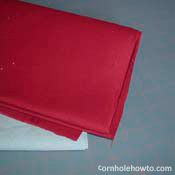 To prevent mass confusion and a potential riot at your cornhole bags’ debut, you will want to have two different colors of fabric in order to keep teams’ progress straight. Themes like college or pro sports are typically popular choices here. Whatever your color scheme of choice, try to pick out sturdy looking duck cloth that is as blemish-free as possible.
To prevent mass confusion and a potential riot at your cornhole bags’ debut, you will want to have two different colors of fabric in order to keep teams’ progress straight. Themes like college or pro sports are typically popular choices here. Whatever your color scheme of choice, try to pick out sturdy looking duck cloth that is as blemish-free as possible.
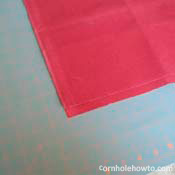 Since the fabric is pretty cheap, I had the folks at Joann’s fabric counter give me a couple extra inches so that I could square the cuts up at home for myself. It turned out to be a good idea; looking at the picture it’s pretty obvious that they gave me some jagged, uneven edges. If that’s the case for you too, go ahead and give those ends a little trim in order to square things up.
Since the fabric is pretty cheap, I had the folks at Joann’s fabric counter give me a couple extra inches so that I could square the cuts up at home for myself. It turned out to be a good idea; looking at the picture it’s pretty obvious that they gave me some jagged, uneven edges. If that’s the case for you too, go ahead and give those ends a little trim in order to square things up.
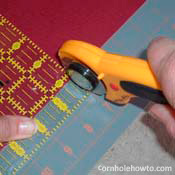 Having been trimmed satisfactorily by either you or the fabric counter, your hunk of duck cloth will probably be a long strip 7” wide by 56” long. Now all you need to do is make the squares for each bag by cutting every 7 inches.
Having been trimmed satisfactorily by either you or the fabric counter, your hunk of duck cloth will probably be a long strip 7” wide by 56” long. Now all you need to do is make the squares for each bag by cutting every 7 inches.
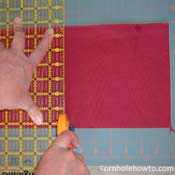 Using the right tools can make things much more accurate and often more convenient. The rolling blade, a gridded cutting mat and a plastic cutting guide really make all this trimming simple, but if you don’t have any of these, a good ruler, a pencil, and some sharp scissors will do the trick.
Using the right tools can make things much more accurate and often more convenient. The rolling blade, a gridded cutting mat and a plastic cutting guide really make all this trimming simple, but if you don’t have any of these, a good ruler, a pencil, and some sharp scissors will do the trick.
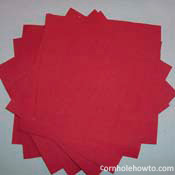 By this point, there should be eight squares of duck cloth, 7 inches by 7 inches, just sitting there on your workspace, practically begging to be sewn up into four bags and stuffed with feed corn. Before plowing ahead, however, this is probably a good time to repeat the previous steps for second team’s color. In the end of this trimming phase, you should have sixteen total squares of duck cloth: eight of one color, eight of another.
By this point, there should be eight squares of duck cloth, 7 inches by 7 inches, just sitting there on your workspace, practically begging to be sewn up into four bags and stuffed with feed corn. Before plowing ahead, however, this is probably a good time to repeat the previous steps for second team’s color. In the end of this trimming phase, you should have sixteen total squares of duck cloth: eight of one color, eight of another.
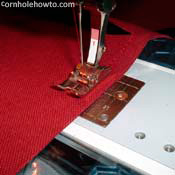 This is where the fun begins. Place two squares of the same color together so that their edges line up exactly; since the fabric is identical on both sides, it shouldn’t matter which side is up unless you want to decorate the outside with an iron-on logo. (If you do have an iron-on or something like that, it’s probably wise to put it on now according to manufacturer’s directions. Go ahead and put it on the inside since we will soon be turning the sewn bags inside-out.) Each seam should be 1/2 inch in from the edge, as shown in the picture. If have a fancy sewing machine like my mother-in-law’s, then you can actually set it to double-stitch all at once. Those with the no-frills model will need to sew a side completely, then repeat again on the same side right next to the first seam in order to get the double-stitch. Either way, the punishing abuse that cornhole bags take requires more than a single stitch. Got an itch to triple-stitch? Why not? Whatever your decision, be sure to back-stitch at all the corners to prevent the thread from unraveling.
This is where the fun begins. Place two squares of the same color together so that their edges line up exactly; since the fabric is identical on both sides, it shouldn’t matter which side is up unless you want to decorate the outside with an iron-on logo. (If you do have an iron-on or something like that, it’s probably wise to put it on now according to manufacturer’s directions. Go ahead and put it on the inside since we will soon be turning the sewn bags inside-out.) Each seam should be 1/2 inch in from the edge, as shown in the picture. If have a fancy sewing machine like my mother-in-law’s, then you can actually set it to double-stitch all at once. Those with the no-frills model will need to sew a side completely, then repeat again on the same side right next to the first seam in order to get the double-stitch. Either way, the punishing abuse that cornhole bags take requires more than a single stitch. Got an itch to triple-stitch? Why not? Whatever your decision, be sure to back-stitch at all the corners to prevent the thread from unraveling.
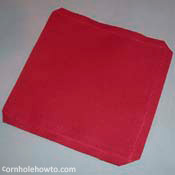 Sew as indicated above for three of the four sides, but be sure to LEAVE ONE SIDE OPEN. You’ll need a hole for getting the corn into the bag. One smart move might also be to trim the corners a little. This will reduce the amount of excess fabric that gets crammed into the corners once we turn the bag inside-out.
Sew as indicated above for three of the four sides, but be sure to LEAVE ONE SIDE OPEN. You’ll need a hole for getting the corn into the bag. One smart move might also be to trim the corners a little. This will reduce the amount of excess fabric that gets crammed into the corners once we turn the bag inside-out.
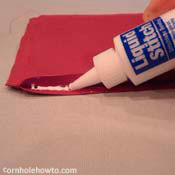 Imagine your embarassment when, after bragging all afternoon to your buddies about your sewing skills, one of your new cornhole bags bursts a seam. We want to do everything in our power to prevent this awkward event. There are no guarentees, of course, but a little bit of fabric glue along the inside of those seams might help ease your mind on this subject. It probably can’t hurt in any case, but it’s an optional safety precaution that the risk-acceptant can skip.
Imagine your embarassment when, after bragging all afternoon to your buddies about your sewing skills, one of your new cornhole bags bursts a seam. We want to do everything in our power to prevent this awkward event. There are no guarentees, of course, but a little bit of fabric glue along the inside of those seams might help ease your mind on this subject. It probably can’t hurt in any case, but it’s an optional safety precaution that the risk-acceptant can skip.
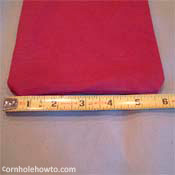 Finally, turn the bag inside-out. Sharp corners are difficult to acheive given the stiffness of the fabric, but you can improve the look of the corners by pushing on the from the inside with a pencil, pen, etc. You’ll notice that once turned out, the bag is now the regulation 6 inches in width.
Finally, turn the bag inside-out. Sharp corners are difficult to acheive given the stiffness of the fabric, but you can improve the look of the corners by pushing on the from the inside with a pencil, pen, etc. You’ll notice that once turned out, the bag is now the regulation 6 inches in width.
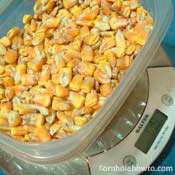 Measure out the corn you’ll need. Each bag should weigh between 14.5 to 16 oz. once filled. The material weighs about .5 oz per bag, so we added 15.5 oz feed corn to each bag to make it one pound in total. As you play, the corn will break up, and your bags will actually lose a bit of weight in the form of dust, so you might want to make it on the heavy end of the acceptable range just to be safe. For this step, you can’t beat a digital baking scale, accurate to 1/8 oz., but if that’s not an option, 2 cups of corn comes pretty close to regulation. If you cannot abide that type of guess-work — good for you!–get the feed store to separate your order in eight individual bags of one pound each at the time of purchase. After all, for the 35 cents you paid for each of those pounds, you deserve some customer service.
Measure out the corn you’ll need. Each bag should weigh between 14.5 to 16 oz. once filled. The material weighs about .5 oz per bag, so we added 15.5 oz feed corn to each bag to make it one pound in total. As you play, the corn will break up, and your bags will actually lose a bit of weight in the form of dust, so you might want to make it on the heavy end of the acceptable range just to be safe. For this step, you can’t beat a digital baking scale, accurate to 1/8 oz., but if that’s not an option, 2 cups of corn comes pretty close to regulation. If you cannot abide that type of guess-work — good for you!–get the feed store to separate your order in eight individual bags of one pound each at the time of purchase. After all, for the 35 cents you paid for each of those pounds, you deserve some customer service.
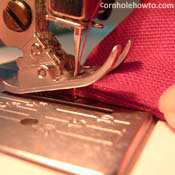 To be honest, the next steps are the trickiest in the whole process and make take some creativity depending on your sewing machine and how stiff the fabric is. Fold the open ends of the filled bag inward to a depth of 1/2 inch to match the rest of the seams you’ve already sewn. We found that a well-placed sewing pin helped to hold the sides closed, and, in order to keep the folds from slipping once under the needle and for overall strength, we applied some of the fabric glue to last, soon-to-be-sewn seam.
To be honest, the next steps are the trickiest in the whole process and make take some creativity depending on your sewing machine and how stiff the fabric is. Fold the open ends of the filled bag inward to a depth of 1/2 inch to match the rest of the seams you’ve already sewn. We found that a well-placed sewing pin helped to hold the sides closed, and, in order to keep the folds from slipping once under the needle and for overall strength, we applied some of the fabric glue to last, soon-to-be-sewn seam.
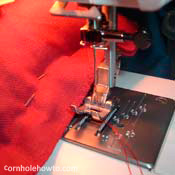 It took us several tries to come up with a good way to keep all that corn in the bag from getting in the way while sewing. We found that pinning the corn bag as shown in the picture helped keep the fabric flat and out of the way of the sewing foot. Placing your stitches as close to the edge as possible will give the bags a nice look. Do not forget to double-stitch here, too.
It took us several tries to come up with a good way to keep all that corn in the bag from getting in the way while sewing. We found that pinning the corn bag as shown in the picture helped keep the fabric flat and out of the way of the sewing foot. Placing your stitches as close to the edge as possible will give the bags a nice look. Do not forget to double-stitch here, too.
 What are you waiting for? Get outside and throw these things at your homemade tables! You’ve worked hard, and the results are bound to be satisfying.
What are you waiting for? Get outside and throw these things at your homemade tables! You’ve worked hard, and the results are bound to be satisfying.
If you decide to buy bags, add a little spice by finding some with logos of your favorite sports team, customized with your initials, etc. You can even get a hold of some that glow in the dark.



